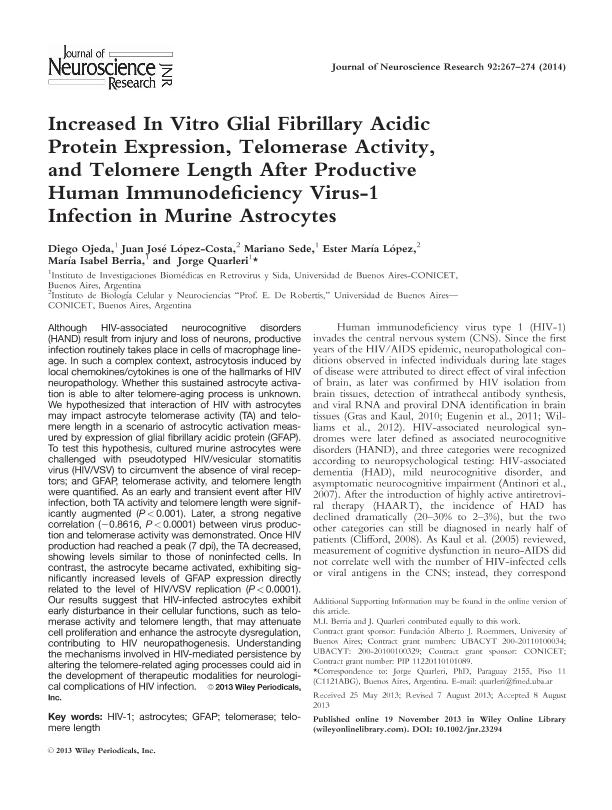Mostrar el registro sencillo del ítem
dc.contributor.author
Ojeda, Diego Sebastian

dc.contributor.author
Lopez, Juan Jose

dc.contributor.author
Sede, Mariano Miguel

dc.contributor.author
Lopez, Ester Maria

dc.contributor.author
Berria, Maria Isabel

dc.contributor.author
Quarleri, Jorge Fabian

dc.date.available
2017-05-26T20:25:00Z
dc.date.issued
2014-02
dc.identifier.citation
Ojeda, Diego Sebastian; Lopez, Juan Jose; Sede, Mariano Miguel; Lopez, Ester Maria; Berria, Maria Isabel; et al.; Increased in vitro glial fibrillary acidic protein expression, telomerase activity, and telomere length after productive human immunodeficiency virus-1 infection in murine astrocytes; Wiley; Journal of Neuroscience Research; 92; 2; 2-2014; 267-274
dc.identifier.issn
0360-4012
dc.identifier.uri
http://hdl.handle.net/11336/17005
dc.description.abstract
Although HIV-associated neurocognitive disorders (HAND) result from injury and loss of neurons, productive infection routinely takes place in cells of macrophage lineage. In such a complex context, astrocytosis induced by local chemokines/cytokines is one of the hallmarks of HIV neuropathology. Whether this sustained astrocyte activation is able to alter telomere-aging process is unknown. We hypothesized that interaction of HIV with astrocytes may impact astrocyte telomerase activity (TA) and telomere length in a scenario of astrocytic activation measured by expression of glial fibrillary acidic protein (GFAP). To test this hypothesis, cultured murine astrocytes were challenged with pseudotyped HIV/vesicular stomatitis virus (HIV/VSV) to circumvent the absence of viral receptors; and GFAP, telomerase activity, and telomere length were quantified. As an early and transient event after HIV infection, both TA activity and telomere length were significantly augmented (P < 0.001). Later, a strong negative correlation (−0.8616, P < 0.0001) between virus production and telomerase activity was demonstrated. Once HIV production had reached a peak (7 dpi), the TA decreased, showing levels similar to those of noninfected cells. In contrast, the astrocyte became activated, exhibiting significantly increased levels of GFAP expression directly related to the level of HIV/VSV replication (P < 0.0001). Our results suggest that HIV-infected astrocytes exhibit early disturbance in their cellular functions, such as telomerase activity and telomere length, that may attenuate cell proliferation and enhance the astrocyte dysregulation, contributing to HIV neuropathogenesis. Understanding the mechanisms involved in HIV-mediated persistence by altering the telomere-related aging processes could aid in the development of therapeutic modalities for neurological complications of HIV infection.
dc.format
application/pdf
dc.language.iso
eng
dc.publisher
Wiley

dc.rights
info:eu-repo/semantics/openAccess
dc.rights.uri
https://creativecommons.org/licenses/by-nc-sa/2.5/ar/
dc.subject
Gfap
dc.subject
Hiv-1
dc.subject
Astrocytes
dc.subject
Telomerase
dc.subject
Telomere Length
dc.subject.classification
Virología

dc.subject.classification
Ciencias Biológicas

dc.subject.classification
CIENCIAS NATURALES Y EXACTAS

dc.title
Increased in vitro glial fibrillary acidic protein expression, telomerase activity, and telomere length after productive human immunodeficiency virus-1 infection in murine astrocytes
dc.type
info:eu-repo/semantics/article
dc.type
info:ar-repo/semantics/artículo
dc.type
info:eu-repo/semantics/publishedVersion
dc.date.updated
2017-05-26T14:43:11Z
dc.identifier.eissn
1097-4547
dc.journal.volume
92
dc.journal.number
2
dc.journal.pagination
267-274
dc.journal.pais
Estados Unidos

dc.journal.ciudad
Hoboken
dc.description.fil
Fil: Ojeda, Diego Sebastian. Consejo Nacional de Investigaciones Científicas y Técnicas. Oficina de Coordinación Administrativa Houssay. Instituto de Investigaciones Biomédicas en Retrovirus y Sida. Universidad de Buenos Aires. Facultad de Medicina. Instituto de Investigaciones Biomédicas en Retrovirus y Sida; Argentina
dc.description.fil
Fil: Lopez, Juan Jose. Consejo Nacional de Investigaciones Científicas y Técnicas. Oficina de Coordinación Administrativa Houssay. Instituto de Biología Celular y Neurociencia "Prof. Eduardo de Robertis". Universidad de Buenos Aires. Facultad de Medicina. Instituto de Biología Celular y Neurociencia ; Argentina
dc.description.fil
Fil: Sede, Mariano Miguel. Consejo Nacional de Investigaciones Científicas y Técnicas. Oficina de Coordinación Administrativa Houssay. Instituto de Investigaciones Biomédicas en Retrovirus y Sida. Universidad de Buenos Aires. Facultad de Medicina. Instituto de Investigaciones Biomédicas en Retrovirus y Sida; Argentina
dc.description.fil
Fil: Lopez, Ester Maria. Consejo Nacional de Investigaciones Científicas y Técnicas. Oficina de Coordinación Administrativa Houssay. Instituto de Biología Celular y Neurociencia "Prof. Eduardo de Robertis". Universidad de Buenos Aires. Facultad de Medicina. Instituto de Biología Celular y Neurociencia ; Argentina
dc.description.fil
Fil: Berria, Maria Isabel. Consejo Nacional de Investigaciones Científicas y Técnicas. Oficina de Coordinación Administrativa Houssay. Instituto de Investigaciones Biomédicas en Retrovirus y Sida. Universidad de Buenos Aires. Facultad de Medicina. Instituto de Investigaciones Biomédicas en Retrovirus y Sida; Argentina
dc.description.fil
Fil: Quarleri, Jorge Fabian. Consejo Nacional de Investigaciones Científicas y Técnicas. Oficina de Coordinación Administrativa Houssay. Instituto de Biología Celular y Neurociencia "Prof. Eduardo de Robertis". Universidad de Buenos Aires. Facultad de Medicina. Instituto de Biología Celular y Neurociencia ; Argentina
dc.journal.title
Journal of Neuroscience Research

dc.relation.alternativeid
info:eu-repo/semantics/altIdentifier/url/http://onlinelibrary.wiley.com/doi/10.1002/jnr.23294/abstract
dc.relation.alternativeid
info:eu-repo/semantics/altIdentifier/doi/http://dx.doi.org/10.1002/jnr.23294
Archivos asociados
